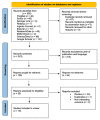Analysis of Caloric and Noncaloric Sweeteners Present in Dairy Products Aimed at the School Market and Their Possible Effects on Health
- PMID: 34578870
- PMCID: PMC8471137
- DOI: 10.3390/nu13092994
Analysis of Caloric and Noncaloric Sweeteners Present in Dairy Products Aimed at the School Market and Their Possible Effects on Health
Abstract
Over the past decades, Mexico has become one of the main sweetener-consuming countries in the world. Large amounts of these sweeteners are in dairy products aimed at the children's market in various presentations such as yogurt, flavored milk, flan, and cheeses. Although numerous studies have shown the impact of sweeteners in adults, the current evidence for children is insufficient and discordant to determine if these substances have any risk or benefit on their well-being. Therefore, this study aimed to describe the sweeteners present in 15 dairy products belonging to the school-age children's market in Mexico and their impact on health. These dairy products were selected through a couple of surveys directed at parents of school-age children. After that, the list of ingredients of each product was analyzed to identify their sweetener content. From there, exhaustive bibliographic research on sweeteners and their possible health effects was carried out, which included 109 articles and 18 studies. The results showed that at a neurological, endocrinological, cardiovascular, metabolic, osseous, renal, hepatic, dental, reticular, carcinogenic, and gut microbiota level; sucrose, fructose, high-fructose corn syrup, maltodextrins, sucralose, and acesulfame K, have a negative effect. While maltodextrins, stevia, polydextrose, and modified starch have a positive one. For these reasons, it is necessary to evaluate the advantages and disadvantages that the consumption of each sweetener entails, as well as a determination of the appropriate acceptable daily intake (ADI).
Keywords: children; dairy products; food additives; fructose; noncaloric sweeteners; sucrose; sweeteners.
Conflict of interest statement
The authors declare no conflict of interest.
Similar articles
-
Use of caloric and noncaloric sweeteners in US consumer packaged foods, 2005-2009.J Acad Nutr Diet. 2012 Nov;112(11):1828-34.e1-6. doi: 10.1016/j.jand.2012.07.009. J Acad Nutr Diet. 2012. PMID: 23102182 Free PMC article.
-
Dietary intakes of six intense sweeteners by Irish adults.Food Addit Contam Part A Chem Anal Control Expo Risk Assess. 2018 Mar;35(3):425-438. doi: 10.1080/19440049.2017.1411619. Epub 2017 Dec 28. Food Addit Contam Part A Chem Anal Control Expo Risk Assess. 2018. PMID: 29210609
-
Noncaloric Sweeteners in Children: A Controversial Theme.Biomed Res Int. 2018 Jan 8;2018:4806534. doi: 10.1155/2018/4806534. eCollection 2018. Biomed Res Int. 2018. PMID: 29511682 Free PMC article. Review.
-
Rate-All-That-Apply (RATA) comparison of taste profiles for different sweeteners in black tea, chocolate milk, and natural yogurt.J Food Sci. 2020 Feb;85(2):486-492. doi: 10.1111/1750-3841.15007. Epub 2020 Jan 22. J Food Sci. 2020. PMID: 31968393
-
Effect of consuming different caloric sweeteners on bone health and possible mechanisms.Nutr Rev. 2008 Jun;66(6):301-9. doi: 10.1111/j.1753-4887.2008.00037.x. Nutr Rev. 2008. PMID: 18522618 Review.
Cited by
-
Newborns from Mothers Who Intensely Consumed Sucralose during Pregnancy Are Heavier and Exhibit Markers of Metabolic Alteration and Low-Grade Systemic Inflammation: A Cross-Sectional, Prospective Study.Biomedicines. 2023 Feb 21;11(3):650. doi: 10.3390/biomedicines11030650. Biomedicines. 2023. PMID: 36979631 Free PMC article.
-
The Impact of Excessive Fructose Intake on Adipose Tissue and the Development of Childhood Obesity.Nutrients. 2024 Mar 25;16(7):939. doi: 10.3390/nu16070939. Nutrients. 2024. PMID: 38612973 Free PMC article. Review.
-
Is There an Academic Bias against Low-Energy Sweeteners?Nutrients. 2022 Mar 29;14(7):1428. doi: 10.3390/nu14071428. Nutrients. 2022. PMID: 35406042 Free PMC article.
References
-
- Wakida-Kuzunoki G.H., Aguiñaga-Villaseñor R.G., Avilés-Cobián R., Baeza-Bacab M.A., Cavagnari B.M., Castillo-Ruíz V., Hernández-Aguilar J.C., López-García R., Martínez-Ramos A., Martínez-Rodríguez N., et al. Edulcorantes no calóricos en la edad pediátrica: Análisis de la evidencia científica. Rev. Mex. Pediatr. 2017;84((Suppl. S1)):3–23.
-
- Manzur-Jattin F., Morales-Nuñez M., Ordosgoitia-Morales J., Quiroz-Mendoza R., Ramos-Villegas Y., Corrales-Santander H. Impacto del uso de edulcorantes no calóricos en la salud cardiometabólica. Rev. Colomb. Cardiol. 2020;27:103–108. doi: 10.1016/j.rccar.2019.11.003. - DOI
-
- Calzada-León R., Ruíz-Reyes M.L., Altamirano-Bustamante N., Padrón-Martínez M.M. Uso de edulcorantes no calóricos en niños. Acta Pediatr. Mex. 2013;34:205–211.
-
- Santillán A., García L.A., Vásquez N., Santoyo V.H., Melgar M., Pereira W., Larrahondo J.E., Merino A. Impacto de la Sustitución del Azúcar de caña por Edulcorantes de Alta Intensidad en México. 1st ed. Universidad Autónoma Chapingo; Texcoc, Mexico: 2017. pp. 32–64.
Publication types
MeSH terms
Substances
LinkOut - more resources
Full Text Sources
Miscellaneous


